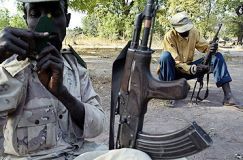Concerns rise over recent clashes in South Sudan
Feb 9, 2006 (KHARTOUM) — Recent clashes between armed militia and the southern Sudanese army in the greater Upper Nile region demonstrate the need to resolve issues of alignment between various armed groups in the area, a spokeswoman for the United Nations said.
 The clashes, which occurred last week, took place despite a 2005 Comprehensive Peace Agreement (CPA) between the main parties in the southern Sudan conflict.
The clashes, which occurred last week, took place despite a 2005 Comprehensive Peace Agreement (CPA) between the main parties in the southern Sudan conflict.
“The recent violence, particularly at Canal Pangak, Uai, Doleib Hill, has a direct relationship with the Juba Declaration, when a part of the South Sudan Defense Force [SSDF] under Paulino Matip joined the SPLA [Sudan People’s Liberation Army],” said Radhia Achouri of the UN Mission in Sudan (UNMIS).
“It is extremely important for the parties to convene a meeting of the Other Armed Groups Collaborative Committee [OAGCC] to finally resolve the issue of alignments,” she told reporters in the Sudanese capital, Khartoum, on Wednesday.
Several civilians died in the clashes between the SPLA and splinter groups of the SSDF – the largest southern militia allied to the north, which fought against the SPLA during the civil war.
The exact number of the dead could not be confirmed. “It could be tens of victims,” Achouri noted.
“We managed to convince the parties to stop the actual fighting,” she added. “And we have the commitment, at least from the two parties to the CPA – that is the SAF [Sudan Armed Forces] and the SPLA – to refrain from the use of violence.”
Under the CPA, signed by the Sudan People’s Liberation Movement/Army (SPLM/A) and the former Sudanese government on 9 January 2005 in Kenya, militia groups in the south were required to disband or join the SAF or the SPLA within a year.
Observers saw the agreement as an important step towards ending a 21-year civil war that claimed two million lives and fulfilling the southerners’ aspirations for greater political autonomy.
On Wednesday, Achouri said some of the groups had not yet clarified how they had aligned themselves.
“We hear that some of them are aligned still to the SAF, but there is other information about some groups that are operating independently,” she said.
“As long as the SAF does not come to us and say, ‘This is the list of the people and the groups who are aligned to us,’ we cannot just speculate,” the UNMIS spokeswoman said.
On 6 February, Matip told reporters in Khartoum that Sudanese military intelligence was responsible for insecurity in southern Sudan.
Matip, who is currently deputy commander-in-chief of the SPLA, said, “We joined the SPLA because the SPLA is the southern army. We signed a declaration – the Juba Declaration [of 8 January] in order to unite the sons and daughters of the south that would also guarantee the unity of the Sudan.
“Since the beginning of the Naivasha [in Kenya] peace talks that led to the signing of the CPA, the government did not want the SSDF and the SPLA to merge,” he added. “The military intelligence in Khartoum encouraged the SSDF to fight the SPLM/A and even to disrupt the peace agreement.”
He warned SSDF leader Gen Gordon Kong, saying: “Gen Gordon Kong does not have soldiers in Jonglei … and will not go to the south [because] the government military intelligence in Khartoum are trying to encourage him to continue to cause insecurity in the south.”
The SSDF has for a long time been considered a major threat to peace and stability in the south, as the militia group controlled large, oil-rich territories in the Upper Nile region and was supported by the Sudanese armed forces.
The Sudanese newspaper Akhbar al-Yawm reported on 5 February that the Sudanese presidency had demanded an explanation from the SPLM/A on recent incidents in Jonglei.
(IRIN)
